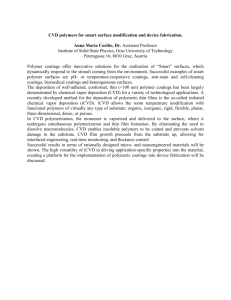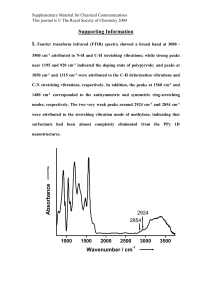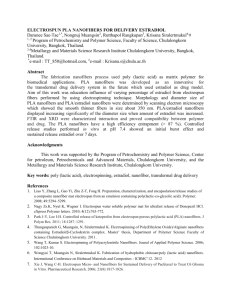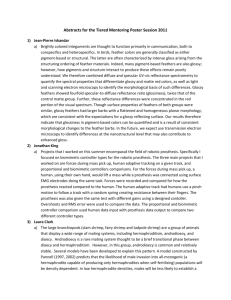Kim_Biomimetic - Harvard University
advertisement
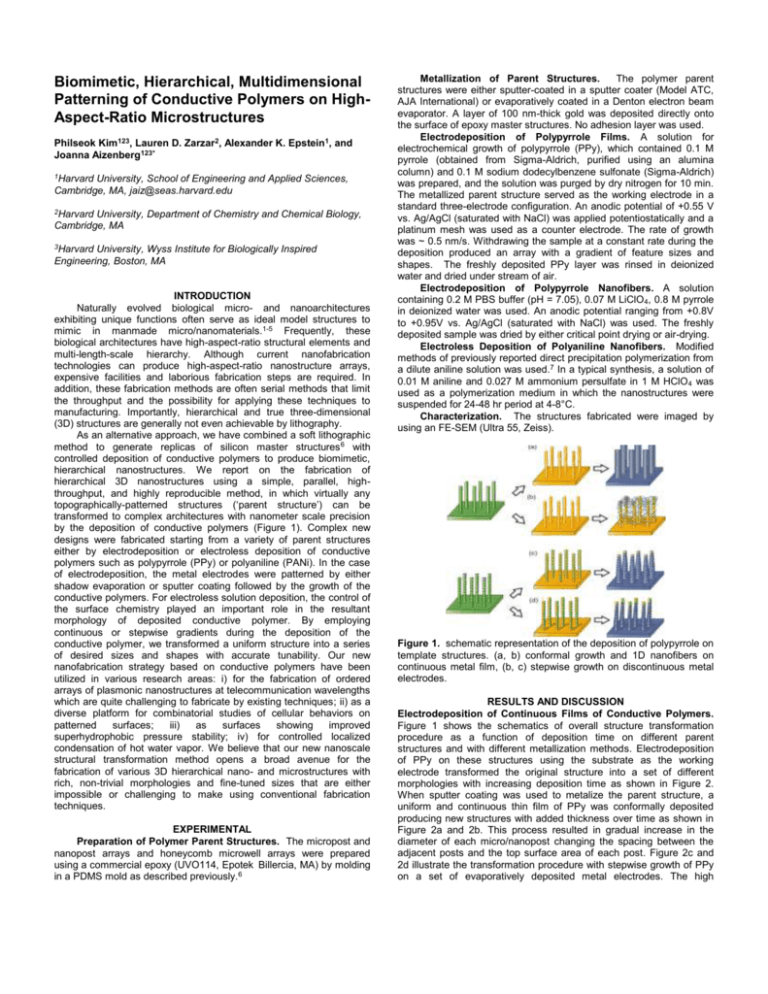
Biomimetic, Hierarchical, Multidimensional Patterning of Conductive Polymers on HighAspect-Ratio Microstructures Philseok Kim123, Lauren D. Zarzar2, Alexander K. Epstein1, and Joanna Aizenberg123* 1Harvard University, School of Engineering and Applied Sciences, Cambridge, MA, jaiz@seas.harvard.edu 2Harvard University, Department of Chemistry and Chemical Biology, Cambridge, MA 3Harvard University, Wyss Institute for Biologically Inspired Engineering, Boston, MA INTRODUCTION Naturally evolved biological micro- and nanoarchitectures exhibiting unique functions often serve as ideal model structures to mimic in manmade micro/nanomaterials.1-5 Frequently, these biological architectures have high-aspect-ratio structural elements and multi-length-scale hierarchy. Although current nanofabrication technologies can produce high-aspect-ratio nanostructure arrays, expensive facilities and laborious fabrication steps are required. In addition, these fabrication methods are often serial methods that limit the throughput and the possibility for applying these techniques to manufacturing. Importantly, hierarchical and true three-dimensional (3D) structures are generally not even achievable by lithography. As an alternative approach, we have combined a soft lithographic method to generate replicas of silicon master structures 6 with controlled deposition of conductive polymers to produce biomimetic, hierarchical nanostructures. We report on the fabrication of hierarchical 3D nanostructures using a simple, parallel, highthroughput, and highly reproducible method, in which virtually any topographically-patterned structures (‘parent structure’) can be transformed to complex architectures with nanometer scale precision by the deposition of conductive polymers (Figure 1). Complex new designs were fabricated starting from a variety of parent structures either by electrodeposition or electroless deposition of conductive polymers such as polypyrrole (PPy) or polyaniline (PANi). In the case of electrodeposition, the metal electrodes were patterned by either shadow evaporation or sputter coating followed by the growth of the conductive polymers. For electroless solution deposition, the control of the surface chemistry played an important role in the resultant morphology of deposited conductive polymer. By employing continuous or stepwise gradients during the deposition of the conductive polymer, we transformed a uniform structure into a series of desired sizes and shapes with accurate tunability. Our new nanofabrication strategy based on conductive polymers have been utilized in various research areas: i) for the fabrication of ordered arrays of plasmonic nanostructures at telecommunication wavelengths which are quite challenging to fabricate by existing techniques; ii) as a diverse platform for combinatorial studies of cellular behaviors on patterned surfaces; iii) as surfaces showing improved superhydrophobic pressure stability; iv) for controlled localized condensation of hot water vapor. We believe that our new nanoscale structural transformation method opens a broad avenue for the fabrication of various 3D hierarchical nano- and microstructures with rich, non-trivial morphologies and fine-tuned sizes that are either impossible or challenging to make using conventional fabrication techniques. EXPERIMENTAL Preparation of Polymer Parent Structures. The micropost and nanopost arrays and honeycomb microwell arrays were prepared using a commercial epoxy (UVO114, Epotek Billercia, MA) by molding in a PDMS mold as described previously.6 Metallization of Parent Structures. The polymer parent structures were either sputter-coated in a sputter coater (Model ATC, AJA International) or evaporatively coated in a Denton electron beam evaporator. A layer of 100 nm-thick gold was deposited directly onto the surface of epoxy master structures. No adhesion layer was used. Electrodeposition of Polypyrrole Films. A solution for electrochemical growth of polypyrrole (PPy), which contained 0.1 M pyrrole (obtained from Sigma-Aldrich, purified using an alumina column) and 0.1 M sodium dodecylbenzene sulfonate (Sigma-Aldrich) was prepared, and the solution was purged by dry nitrogen for 10 min. The metallized parent structure served as the working electrode in a standard three-electrode configuration. An anodic potential of +0.55 V vs. Ag/AgCl (saturated with NaCl) was applied potentiostatically and a platinum mesh was used as a counter electrode. The rate of growth was ~ 0.5 nm/s. Withdrawing the sample at a constant rate during the deposition produced an array with a gradient of feature sizes and shapes. The freshly deposited PPy layer was rinsed in deionized water and dried under stream of air. Electrodeposition of Polypyrrole Nanofibers. A solution containing 0.2 M PBS buffer (pH = 7.05), 0.07 M LiClO 4, 0.8 M pyrrole in deionized water was used. An anodic potential ranging from +0.8V to +0.95V vs. Ag/AgCl (saturated with NaCl) was used. The freshly deposited sample was dried by either critical point drying or air-drying. Electroless Deposition of Polyaniline Nanofibers. Modified methods of previously reported direct precipitation polymerization from a dilute aniline solution was used.7 In a typical synthesis, a solution of 0.01 M aniline and 0.027 M ammonium persulfate in 1 M HClO 4 was used as a polymerization medium in which the nanostructures were suspended for 24-48 hr period at 4-8°C. Characterization. The structures fabricated were imaged by using an FE-SEM (Ultra 55, Zeiss). Figure 1. schematic representation of the deposition of polypyrrole on template structures. (a, b) conformal growth and 1D nanofibers on continuous metal film, (b, c) stepwise growth on discontinuous metal electrodes. RESULTS AND DISCUSSION Electrodeposition of Continuous Films of Conductive Polymers. Figure 1 shows the schematics of overall structure transformation procedure as a function of deposition time on different parent structures and with different metallization methods. Electrodeposition of PPy on these structures using the substrate as the working electrode transformed the original structure into a set of different morphologies with increasing deposition time as shown in Figure 2. When sputter coating was used to metalize the parent structure, a uniform and continuous thin film of PPy was conformally deposited producing new structures with added thickness over time as shown in Figure 2a and 2b. This process resulted in gradual increase in the diameter of each micro/nanopost changing the spacing between the adjacent posts and the top surface area of each post. Figure 2c and 2d illustrate the transformation procedure with stepwise growth of PPy on a set of evaporatively deposited metal electrodes. The high the areas of a substrate spent in the electrochemical cell. This procedure was performed by continuously withdrawing the substrate from the electrochemical cell using a syringe pump or an automatic dip-coater during the electrochemical deposition. Multiple gradients (e.g. orthogonal or triaxial) can also be formed on a single substrate by rotating the substrate and running the substrate through two or more electrochemical depositions with a linear gradient in each run. The gradient deposition created substrates with a set of nanostructures (e.g. 250 different patterns in 3 cm2 were fabricated) with precisely controlled dimensions that can serve as unique platforms for combinatorial studies in many areas, such as the studies on the behaviors of cells and other organisms on patterned and biocompatible surfaces as well as the effect of size and shape of surface patterns on the crystallization of minerals. Figure 2. SEM images of modified nanostructures of polymer parent template as a function of conductive polymer growth time. (a,b) opencell structures (nano/micropost) with conformal growth, (c,d) open-cell structures with stepwise growth, (e,f) closed-cell structures with conformal growth over all surface, (e), and only on the top surface, (f). directionality of metal flume prevents the metal from depositing on shadowed areas due to the sidewall corrugation, a trait of Bosch etching process called ‘scalloping’, present in the parent structure. This effectively yielded a set of separated electrodes (top surface of each post and the separated rings on each scallop) on each post and the continuous electrode on the substrate surface. The polymer film was initially grown on the substrate surface then it electrically connected the next electrode ring when the thickness of the polymer layer became thick enough to bridge the gap. With continued growth of the polymer, the bottom of each post became gradually thicker forming a cone shaped (“Christmas tree” shape) micropost array. Meanwhile, the substrate surface was elevated due to continuous growth of the polymer film. Figure 2d illustrates the transformation procedure, when the electrodes were deposited at an angle from the evaporation source by tilting the substrate. Such evaporation resulted in split-ring electrodes on each scallop. Electrodeposition of PPy film on this substrate transformed array of straight posts into array of slightly tilted posts along one direction. These modified post arrays can be replicated into epoxy by double molding in PDMS. The cone shaped posts are useful structures for improved mechanical stability and the pre-tilted structure may be useful for studying the unidirectional wetting behavior of water droplet. Furthermore, the replicated structure with another set of evaporated electrodes may serve as a new parent substrate for further modification of the structure to create even more complex 3D nanostructures. Closed-cell structures (e.g. an array of honeycombs or rectangles) were also used as parent structures in electrodeposition of PPy. The substrate was covered with conformally grown PPy when sputter coated electrode was used reducing the diameter of wells from 40 μm continuously to ~20 μm (Figure 2e). When shadow-evaporated electrodes were used, only the rims of each closed-cell were electrically connected and the electrodepositon took place from the top surface rather than from the electrically isolated substrate surface. This procedure effectively increased the depth of the cell due to the added thickness to the rim by vertically growing polymer layer (Figure 2f). Continued growth of the polymer layer on the rims resulted in lateral growth of polymer forming structures with overhanging providing reentrant curvature. All of the above mentioned electrodeposition procedures can be performed in continuous or stepwise gradients by varying the time that Fabrication of Hierarchical Nanostructures by Electro- or Electroless Formation of Conductive Polymer Nanofibers. Recently, there have been a number of reports on template-free preparation methods of 1D nanofibers of conductive polymers utilizing dimers or oligomers as a shape-directing agent8, using a certain concentration of hydrogen-bonding counterions in the electrolytes9, 10, and using a low concentration of monomers in the solution7. The detailed mechanism of the formation of 1D nanofibers is unclear. However, it is believed that the multivalent acidic electrolytes, once ionized under neutral/basic conditions, can form hydrogen bonding to the growing PPy chains and facilitate clustering of the polymer chains into fibers.9 Obtaining aligned 1D nanofibers from a template-free solution is even more challenging. In a recent paper by Manohar et al., it was reported that the presence of a solid surface plays an important role in the nucleation and growth of ordered, aligned 1D nanofibers of conductive polymers.11 We grew PPy and PANi nanofibers on high-aspect-ratio nanopost arrays and closed-cell microstructures to create hierarchical structures exhibiting roughness at multiple length scales (Figure 3). These multitier hierarchical nano/microstructures have structural similarity to the surface of many biological systems such as lotus leaf and the feet of water striders that exhibit superhydrophobic properties. Their unique superhydrophobicity is typically attributed to the structural effect (e.g. hierarchy, reentrance curvatures) combined with the chemical nature of the surface. The surface of a square array of polymer nanoposts (250 nm diameter, 8 um height, 2 um pitch) decorated with PPy or PANi nanofiber showed superhydrophilicity (CA ~ 0 deg.). These surfaces may be used as a substrate to immobilize and stretch nucleic acids, proteins, and cells to study their interactions. The same hierarchical surface can be rendered superhydrophobic by coating the surface with fluorinated silane. These hierarchical nanostructures show improved superhydrophobicity and may be useful for highpressure applications, selected and localized condensation. Studies on the pressure stability of these biomimetic hierarchical structures with multi-tier roughness are underway. Figure 3. SEM images of modified nanostructures of polymer parent template with 1D nanofibers creating hierarchical roughness and increased reentrance curvature. (a,b) network of long polypyrrole nanofibers, (c) short, aligned polyaniline nanofibers assembled on the hydrophobic nanopost surface, (d) partial surface modification with polyaniline nanofibers by using superhydrophobic effect of the parent structure. CONCLUSIONS We have developed a new simple and versatile nanofabrication method using electrodepositon of conductive polymer layers with controlled morphology on virtually any substrate with precise control of size and shape of the resultant structures. Our method has generated a wide variety of non-trivial 3D structures that are very challenging to fabricate by using conventional techniques. The fabricated structures have already been in use in many on-going interesting studies that will be published subsequently. We are further developing this method to create more intricate and dynamic structures by combining several different substrate architectures and the electrochemomechanical actuation of such structures. Our method adds new options to existing nanofabrication techniques with unique morphology, precise control of their size and shape and high reproducibility, which we believe will inspire the scientists and engineers in many areas. ACKNOWLEDGEMENTS This project was partially supported by the MRSEC program of the National Science Foundation under award number DMR-082048 and by the WYSS Institute for Biologically Inspired Engineering at Harvard University. The work was performed in part at the Center for Nanoscale Systems (CNS), a member of the National Nanotechnology Infrastructure Network (NNIN), which is supported by the National Science Foundation under NSF award number ECS-0335765. REFERENCES Bhushan, B. Philosophical Transactions of The Royal Society A, 2009, 367, 1445-1486. 2. Burgert, I.; Fratzl, P. Philosophical Transactions of The Royal Society A, 2009, 367, 1541-1557. 3. Pokroy, B.; Kang, S. H.; Mahadevan, L.; Aizenberg, J. Science, 2009, 323, 237-240. 4. Sidorenko, A.; Krupenkin, T.; Taylor, A.; Fratzl, P.; Aizenberg, J. Science, 2007, 315, 487-490. 5. Kim, P.; Zarzar, L. D.; Zhao, X.; Sidorenko, A.; Aizenberg, J. Soft Matter 2010, 6, 750-755. 6. Pokroy, B.; Epstein, A. K.; Persson-Gulda, M. C. M.; Aizenberg, J. Advanced Materials, 2009, 21, 463-469. 7. Chiou, N.-r.; Lu, C.; Guan, J.; Lee, L. J.; Epstein, A. J. Nature Nanotechnology, 2007, 2, 354-357. 8. Tran, H. D.; Wang, Y.; D’Arcy, J. M.; Kaner, R. B. ACS Nano, 2008, 9, 1841-1848. 9. Zang, J.; Li, C. M.; Bao, S. J.; Cui, X.; Bao, Q.; Sun, C. Q. Macromolecules, 2008, 41, 7053-7057. 10. Debiemme-Chouvy, C. Electrochemical Communication, 2009, 11, 298-301. 11. Surwade, S. P.; Manohar, N.; Manohar S. K. Macromolecules, 2009, 42, 1792-1795. 1.

